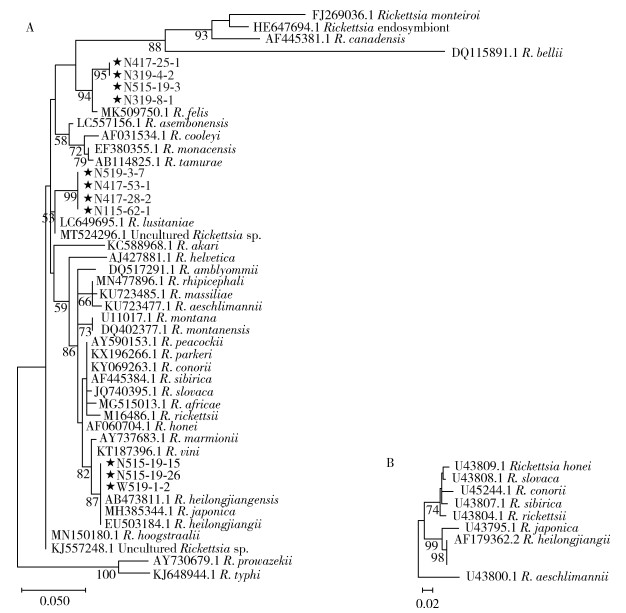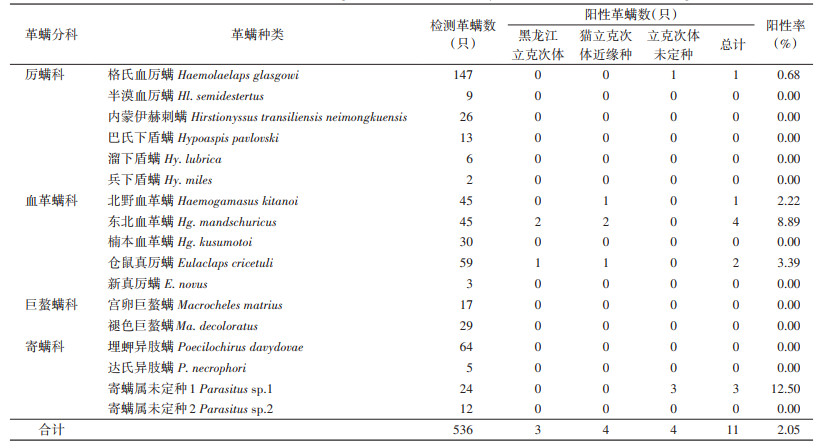| [1] |
张云, 朱进, 邓小昭, 等. 革螨、恙螨传播肾综合征出血热病毒的实验研究[J]. 中华流行病学杂志, 2001, 22(5): 352-354. Zhang Y, Zhu J, Deng XZ, et al. Experimental study on the roles of gasmid mite and chigger mite in the transmission of hemorrhagic fever with renal syndrome virus[J]. Chin J Epidemiol, 2001, 22(5): 352-354. DOI:10.3760/j.issn:0254-6450.2001.05.013 |
|
| [2] |
Moro CV, Chauve C, Zenner L. Vectorial role of some dermanyssoid mites (Acari, Mesostigmata, Dermanyssoidea)[J]. Parasite, 2005, 12(2): 99-109. DOI:10.1051/parasite/2005122099 |
|
| [3] | |
|
| [4] | |
|
| [5] |
张丽娟. 中国立克次体病监测及防治现状与展望[J]. 疾病监测, 2007, 22(9): 577-579. Zhang LJ. Prospect and status of rickettsioses surveillance in China[J]. Dis Surveill, 2007, 22(9): 577-579. DOI:10.3784/j.issn.1003-9961.2007.09.001 |
|
| [6] |
邓国潘. 中国经济昆虫志. 第四十册. 蜱螨亚纲: 皮刺螨总科[M]. 北京: 科学出版社, 1993: 26-300.
Deng GP. Economic insect fauna of China, Fasc. 40, Acari: Dermanyssoideae[M]. Beijing: Science Press, 1993: 26-300.
|
|
| [7] |
殷绥公, 贝纳新, 陈万鹏. 中国东北土壤革螨[M]. 北京: 中国农业出版社, 2013: 121-224.
Yin SG, Bei NX, Chen WP. Gamasid mites in soil of northeast China[M]. Beijing: China Agriculture Press, 2013: 121-224.
|
|
| [8] |
Sanprick A, Yooyen T, Rodkvamtook W. Survey of Rickettsia spp. and Orientia tsutsugamushi pathogens found in animal vectors (Ticks, Fleas, Chiggers) in Bangkaew district, Phatthalung province, Thailand[J]. Korean J Parasitol, 2019, 57(2): 167-173. DOI:10.3347/kjp.2019.57.2.167 |
|
| [9] |
卢志宇, 付梦姣, 熊进峰, 等. 湖北省东北部地区蜱携立克次体的调查[J]. 军事医学, 2021, 45(4): 262-266. Lu ZY, Fu MJ, Xiong JF, et al. Investigation of rickettsiae in ticks from the northeast of Hubei province[J]. Mil Med Sci, 2021, 45(4): 262-266. DOI:10.7644/j.issn.1674-9960.2021.04.005 |
|
| [10] |
Díaz-Sánchez AA, Corona-González B, Meli ML, et al. Molecular diagnosis, prevalence and importance of zoonotic vector-borne pathogens in Cuban shelter dogs-A preliminary study[J]. Pathogens, 2020, 9(11): 901. DOI:10.3390/pathogens9110901 |
|
| [11] |
Chitanga S, Chambaro HM, Moonga LC, et al. Rickettsia lusitaniae in Ornithodoros porcinus ticks, Zambia[J]. Pathogens, 2021, 10(10): 1306. DOI:10.3390/pathogens10101306 |
|
| [12] |
Han SW, Chae JB, Jo YS, et al. First detection of Borrelia and Rickettsia species from Ornithodoros ticks in the Republic of Korea[J]. Ticks Tick Borne Dis, 2021, 12(4): 101689. DOI:10.1016/j.ttbdis.2021.101689 |
|
| [13] |
Fujita H, Takada N, Chaithong U. Preliminary report on rickettsial strains of spotted fever group isolated from ticks of China, Nepal and Thailand[J]. Annu Rep Ohara Gen Hosp, 2002, 44: 15-18. |
|
| [14] |
Fournier PE, Dumler JS, Greub G, et al. Gene sequence-based criteria for identification of new Rickettsia isolates and description of R. heilongjiangensis sp. nov.[J]. J Clin Microbiol, 2003, 41(12): 5456-5465. DOI:10.1128/JCM.41.12.5456-5465.2003 |
|
| [15] |
张婧, 张毅波, 薛延韬, 等. 昆虫次生内共生菌 Rickettsia研究进展[J]. 环境昆虫学报, 2017, 39(2): 431-443. Zhang J, Zhang YB, Xue YT, et al. Research advances on a secondary endosymbiont Rickettsia in insect[J]. J Environ Entomol, 2017, 39(2): 431-443. DOI:10.3969/j.issn.1674-0858.2017.02.24 |
|
| [16] |
张丽娟, 付秀萍, 范明远. 我国立克次体研究与立克次体病的流行现状[J]. 热带病与寄生虫学, 2005, 3(1): 37-42. Zhang LJ, Fu XP, Fan MY. Research on rickettsiae and rickettsial disease and epidemic situation in China[J]. J Trop Dis Parasitol, 2005, 3(1): 37-42. DOI:10.3969/j.issn.1672-2302.2005.01.016 |
|
| [17] |
Zhang LJ, Han J, Xu JG, et al. Identification of a new serotype of Rickettsia heilongjiangensis in wild rats from Guangdong province, China[J]. Clin Microbiol Infect, 2009, 15(2): 338-339. DOI:10.1111/j.1469-0691.2008.02266.x |
|
| [18] |
Wang Q, Pan YS, Jiang BG, et al. Prevalence of multiple tick-borne pathogens in various tick vectors in Northeastern China[J]. Vector Borne Zoonotic Dis, 2021, 21(3): 162-171. DOI:10.1089/vbz.2020.2712 |
|
| [19] |
Sun JM, Lin JF, Gong ZY, et al. Detection of spotted fever group rickettsiae in ticks from Zhejiang province, China[J]. Exp Appl Acarol, 2015, 65(3): 403-411. DOI:10.1007/s10493-015-9880-9 |
|
| [20] |
Gillespie JJ, Williams K, Shukla M, et al. Rickettsia phylogenomics: Unwinding the intricacies of obligate intracellular life[J]. PLoS One, 2008, 3(4): e2018. DOI:10.1371/journal.pone.0002018 |
|
| [21] |
Van Der Geest LP, Elliot SL, Breeuwer JAJ, et al. Diseases of mites[J]. Exp Appl Acarol, 2000, 24(7): 497-560. DOI:10.1023/a:1026518418163 |
|
| [22] |
Reeves WK, Loftis AD, Szumlas DE, et al. Rickettsial pathogens in the tropical rat mite Ornithonyssus bacoti (Acari: Macronyssidae) from Egyptian rats ( Rattus spp.)[J]. Exp Appl Acarol, 2007, 41(1/2): 101-107. DOI:10.1007/s10493-006-9040-3 |
|
| [23] |
Tsui PY, Tsai KH, Weng MH, et al. Molecular detection and characterization of spotted fever group rickettsiae in Taiwan[J]. Am J Trop Med Hyg, 2007, 77(5): 883-890. DOI:10.4269/ajtmh.2007.77.883 |
|
| [24] |
任天广, 郭宪国. 中国皮刺螨总科区系研究报告[J]. 中国病原生物学杂志, 2009, 4(2): 99-104. Ren TG, Guo XG. Preliminary study on Dermanyssoidea fauna in China[J]. J Pathog Biol, 2009, 4(2): 99-104. DOI:10.13350/j.cjpb.2009.02.011 |
|
| [25] |
Yu XJ, Tesh RB. The role of mites in the transmission and maintenance of Hantaan virus ( Hantavirus: Bunyaviridae)[J]. J Infect Dis, 2014, 210(11): 1693-1699. DOI:10.1093/infdis/jiu336 |
|
| [26] |
吴益民, 杨国平, 王洪军. 对黑龙江立克次体和远东蜱传斑点热调查研究的思考[J]. 中国人兽共患病学报, 2008, 24(11): 1083-1084. Wu YM, Yang GP, Wang HJ. Reflections on the investigation and research of Rickettsia heilongjiangensis and tick-borne spotted fever in the Far East[J]. Chin J Zoonoses, 2008, 24(11): 1083-1084. DOI:10.3969/j.issn.1002-2694.2008.11.025 |
|
| [27] |
Mediannikov OY, Sidelnikov Y, Ivanov L, et al. Acute tick-borne rickettsiosis caused by Rickettsia heilongjiangensis in the Russian Far East[J]. Emerg Infect Dis, 2004, 10(5): 810-817. DOI:10.3201/eid1005.030437 |
|
| [28] |
Kasama K, Fujita H, Yamamoto S, et al. Genomic features of Rickettsia heilongjiangensis revealed by intraspecies comparison and detailed comparison with R. japonica[J]. Front Microbiol, 2019, 10: 2787. DOI:10.3389/fmicb.2019.02787 |
|
| [29] |
Takajo I, Kurosawa M, Sakata A, et al. Human Rickettsia heilongjiangensis infection, Japan[J]. Emerg Infect Dis, 2010, 16(8): 1306-1308. DOI:10.3201/eid1608.100049 |
|
| [30] |
Granitov V, Shpynov S, Beshlebova O, et al. New evidence on tick-borne rickettsioses in the Altai region of Russia using primary lesions, serum and blood clots of molecular and serological study[J]. Microbes Infect, 2015, 17(11/12): 862-865. DOI:10.1016/j.micinf.2015.08.011 |
|
| [31] |
崔云虹, 刘丹, 乌兰图雅, 等. 2016-2019年内蒙古大兴安岭林区立克次体关联细菌群监测[J]. 现代预防医学, 2021, 48(15): 2850-2856. Cui YH, Liu D, Wulan TY, et al. Tick surveillance for Rickettsia-associated bacterial communitie in the Greater Xing'an Mountains, Inner Mongolia, 2016-2019[J]. Mod Prev Med, 2021, 48(15): 2850-2856. |
|
| [32] |
周磊, 汤芳, 栾进, 等. 内蒙古奇乾地区蜱携带斑点热立克次体的调查[J]. 中国国境卫生检疫杂志, 2017, 40(2): 96-99. Zhou L, Tang F, Luan J, et al. Investigation on spotted fever group rickettsiae in ticks collected from Qiqian areas of Inner Mongolia[J]. Chin J Front Health Quar, 2017, 40(2): 96-99. DOI:10.16408/j.1004-9770.2017.02.006 |
|
| [33] |
杨晓珊, 黎海滨, 严志东, 等. 猫立克次体合并鲍曼不动杆菌感染一例报告及用药分析[J]. 临床药物治疗杂志, 2021, 19(11): 84-86. Yang XS, Li HB, Yan ZD, et al. Rickettsia felis complicated with Acinetobacter baumannii infection: A case report and drug use analysis[J]. Clin Med J, 2021, 19(11): 84-86. DOI:10.3969/j.issn.1672-3384.2021.11.018 |
|
| [34] |
张丽丽, 张俊湖, 胡铭, 等. 感染猫立克次体导致重症脑炎1例报告[J]. 中华危重病急救医学, 2021, 33(4): 491-493. Zhang LL, Zhang JH, Hu M, et al. Severe encephalitis caused by infection of Rickettsia felis: A case report[J]. Chin Crit Care Med, 2021, 33(4): 491-493. DOI:10.3760/cma.j.cn121430-20201110-00709 |
|
| [35] |
Milhano N, Palma M, Marcili A, et al. Rickettsia lusitaniae sp. nov. isolated from the soft tick Ornithodoros erraticus (Acarina: Argasidae)[J]. Comp Immunol Microbiol Infect Dis, 2014, 37(3): 189-193. DOI:10.1016/j.cimid.2014.01.006 |
|
 2023, Vol. 34
2023, Vol. 34









